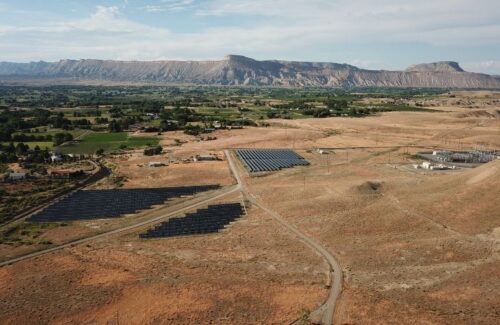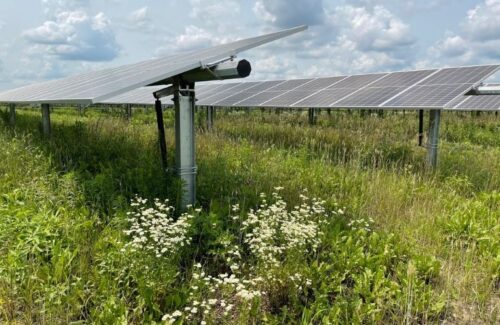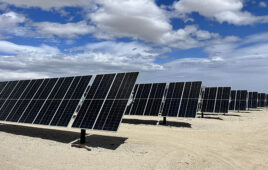
Pivot Energy’s Mesa 2 Community Solar Garden in Colorado, with electricity transmission infrastructure visible in the background.
By Kacie Peters, director of industry relationships, Pivot Energy
Businesses and individuals alike love to capitalize on new ways to save money, and a utility bill is a natural place to start. Over the past few years, community solar has offered this opportunity to many electricity customers across the country. The impact is growing with over 3 GW of installed capacity to date. Community solar is poised for even more growth, so it is the right time to consider some strategic policy improvements to further reduce costs and bring subscribers even more value.
The following areas are ripe for improvement:
- Structural factors that make community solar more expensive to operate than other distributed generation (DG) projects, and
- Policies that undervalue the full contribution of subscribers to the power grid.
Solving these limitations will increase subscriber benefits, make projects more financeable and ultimately unlock more community solar markets. Let’s unpack how to make it happen.
Addressing the cost of community solar
First, let’s start with the most obvious solution – reducing the cost of community solar itself.
Solar prices increased in 2021, and community solar pricing was no exception. Some of the rise in cost can be attributed to long interconnection queues as projects face uncertainty on timelines and cost. Community solar projects should be at an advantage in this area, as distributed generation inherently eases the burden placed on the grid and reduces losses that occur when electricity is transmitted over great distances. Because of this benefit, current community solar costs do not accurately reflect the value that it is bringing to the grid.
Policymakers and program designers should recognize that community solar isn’t just a “perk” for participants and asset owners. Research from Local Solar for All suggests that developing distributed generation assets like community solar is the most cost-effective way to transition to clean energy, solidify the grid, and reduce the need for new transmission assets. Deploying 247 gigawatts of solar would offer a path to 95% emissions reductions while supporting 2 million jobs and saving ratepayers $473 billion. When focusing specifically on grid impacts, the data shows that developing distributed solar generation would save $88 billion. Clearly, community solar development has immense positive externalities for the grid system and policies should reflect that.
Almost a decade ago, Minnesota recognized these benefits and instituted a “Value of Solar” tariff that increased subscriber savings by creating a new credit class for community solar. Likewise, New York’s Value of Distributed Energy Resources (VDER) pricing accounts for the benefits of solar in real time and thus the credits often reflect the full cost of a subscriber’s electric bill. Markets should not artificially reduce credit values, but instead make them accurately compensate for production. When these fixes are implemented, savings will increase accordingly.
Addressing the cost to finance
The unique financial configuration of community solar offers flexibility for subscribers, developers and operators, but in turn, results in some challenges. Most notably, financing costs are higher for community solar because investors view a structure with hundreds of different subscribers as a riskier endeavor. These costs eventually trickle down to subscribers in the form of higher prices (and lower savings).
A traditional power purchase agreement (PPA) has one customer for all the electricity, whether that be a household, business, public sector organization or utility company. Risk is relatively low, or at least easier to assess, because there is a single customer for the electricity. This customer is also typically vetted through the sales process to ensure that they are a credit-worthy entity.
While community solar is inherently different due to the fact that many customers exist for a single project, there are ways to reduce the risk for financiers. A policy framework known as “consolidated billing” is a huge step to remedying this issue. New York rolled out such a policy in 2020 that eliminated the need for subscribers to pay two bills, one to the utility and another to the community solar project owner.
This framework dramatically reduces the risk and cost across the entire community solar value chain. Financiers love this mechanism, because it eliminates the need for a community solar owner to directly bill and collect payments from a high number of subscribers for a single project. Instead, the utility manages payments through their normal billing and collection process. Subscribers love it too, because a more streamlined experience means less paperwork to deal with each month. More importantly, it removes a key barrier to getting new subscribers in the first place.
While it’s too early to tell the full impact this will have on underwriting community solar, financiers have already become more comfortable removing FICO score requirements for community solar subscribers. This trend is likely to continue as community solar builds more of a track record in the industry and consolidated billing expands.
Increasing the value of community solar

Flowers grow beneath Pivot Energy’s Community Solar Garden in Kankakee, Illinois.
By decreasing costs and better capturing the inherent value of community solar for the grid, developers should be able to pass along higher savings to subscribers. While it may take some time for competitiveness in the marketplace to push savings beyond the typical 10% threshold, subscribers can still benefit by having a larger portion of their electricity bill offset by community solar.
In almost all community solar markets, subscribers are faced with non-bypassable fees and program operation costs on their energy bills. In markets like Illinois, fixed charges account for about 50% of a subscriber’s energy bill. In Oregon, program administrators charge as much as $1.05 per kilowatt to participate in the program, eating 70% of the subscriber’s savings. Increasing the total pie of what a subscriber can save on their electric bills will have a big impact over time.
When savings increase, we all win
The savings earned by businesses and households through community solar are tremendously helpful in the face of high inflation, especially for energy costs. Community solar was designed to create equitable access to clean electricity and it has so far been a success. Low-income households, which often miss out on the benefits of on-site solar and spend a far greater portion of their household income on electricity can now benefit from more equitable access to clean energy. These households sometimes spend three-times more than non-low-income households on utility bills. This is the main reason why we should be working to squeeze out every additional dollar of savings we can for subscribers.
By fixing the most glaring inefficiencies of community solar, companies can maintain (or even increase) their competitive edge in the solar market while meaningfully increasing savings for subscribers. This societal benefit won’t go unnoticed. Policymakers are more likely to embrace new programs and subscribers are more likely to sign on to projects, creating a virtuous cycle for everyone. So let’s make some quick policy fixes to grow solar for everyone.
For over a decade, Kacie Peters has been an innovator, communicator, and mentor for the distributed solar and storage industry. She has pioneered new markets and sales strategies for organizations including SunEdison and Alta Energy, while she has also held board positions at COSSA and ISEA. Currently, Peters serves as the Director of Industry Relationships for Pivot Energy where she develops marketing strategies for project M&A, co-development, and SunCentral, Pivot’s proprietary community solar servicing tool.







Tell Us What You Think!